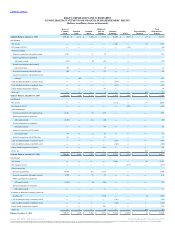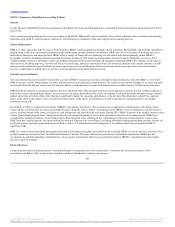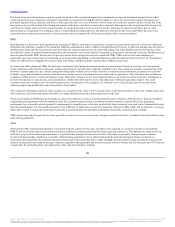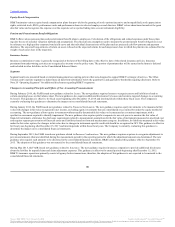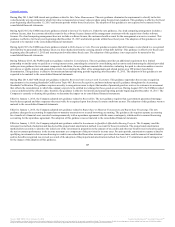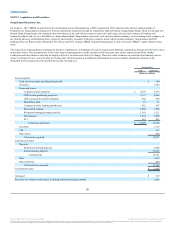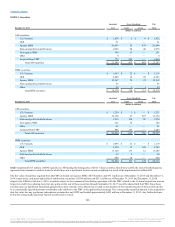BB&T 2015 Annual Report Download - page 102
Download and view the complete annual report
Please find page 102 of the 2015 BB&T annual report below. You can navigate through the pages in the report by either clicking on the pages listed below, or by using the keyword search tool below to find specific information within the annual report.
TableofContents
Residential mortgage NPLs secured by 1-4 family properties are generally charged down to the fair value of the collateral securing the loan less costs to sell
upon becoming 120 days past due, unless the shortfall is covered by private mortgage insurance. Nonperforming residential mortgage TDRs generally incur
charge-offs at 120 days. If a known loss is identified prior to these time periods, the applicable charge-off occurs immediately. BB&T recognizes charge-offs
on government guaranteed NPLs to the extent that the carrying value of the NPL exceeds the guaranteed amount.
During the fourth quarter of 2015, BB&T implemented a residential mortgage and direct retail lending policy change to move loans to nonaccrual status at
120 days past due instead of 180 days.
Charge-offs are recorded on revolving credit loans after they become 180 days past due and commercial bank card balances after they become 90 days past
due. Unpaid fees and finance charges are reversed against interest income in the period in which the charge-off occurs. Other retail loans not secured by 1-4
family properties are charged down to the fair value of the collateral securing the loan less costs to sell upon becoming between 90 and 120 days past due,
depending on the type of loan.
Secured retail loans discharged through bankruptcy are charged down to the fair value of the related collateral, and the remaining balance is placed on
nonaccrual status.
Certain past due loans may remain on accrual status if management determines that it does not have concern over the collectability of principal and interest.
Generally, when loans are placed on nonaccrual status, accrued interest receivable is reversed against interest income in the current period. Interest payments
received thereafter are applied as a reduction to the remaining principal balance as long as concern exists as to the ultimate collection of the principal.
Nonaccrual mortgage loans are accounted for using the cash basis. Loans and leases are generally removed from nonaccrual status when they become current
as to both principal and interest and concern no longer exists as to the collectability of principal and interest.
Assets acquired as a result of foreclosure are subsequently carried at the lower of cost or net realizable value. Net realizable value equals fair value less
estimated selling costs. Any excess of cost over net realizable value at the time of foreclosure is charged to the ALLL. NPAs are subject to periodic
revaluations of the collateral underlying impaired loans and foreclosed real estate. The periodic revaluations are generally based on the appraised value of
the property and may include additional liquidity adjustments based upon the expected retention period. BB&T’s policies require that valuations be updated
at least annually and that upon foreclosure, the valuation must not be more than six months old, otherwise an updated appraisal is required. Routine
maintenance costs, other costs of ownership, subsequent declines in fair value and net losses on disposal are included in foreclosed property expense.
ACL
The ACL includes the ALLL and the RUFC. The ACL represents management’s best estimate of probable credit losses inherent in the loan and lease
portfolios and off-balance sheet lending commitments at the balance sheet date. Estimates for loan and lease losses are determined by analyzing historical
loan and lease losses, historical loan and lease migration to charge-off experience, current trends in delinquencies and charge-offs, expected cash flows on
purchased loans, current assessment of problem loans and leases, the results of regulatory examinations and changes in the size, composition and risk
assessment of the loan and lease portfolio. As part of this process, BB&T develops a series of loss estimate factors, which are modeled projections of the
frequency, timing and severity of losses. Changes to the ACL are made by charges to the provision for credit losses, which is reflected in the Consolidated
Statements of Income. Loan or lease balances deemed to be uncollectible are charged off against the ALLL. Recoveries of amounts previously charged off are
credited to the ALLL. The methodology used to determine the RUFC is inherently similar to that used to determine the collectively evaluated component of
the ALLL, adjusted for factors specific to binding commitments, including the probability of funding and exposure at default. While management uses the
best information available to establish the ACL, future adjustments may be necessary if economic conditions differ substantially from the assumptions used
in computing the ACL or, if required by regulators based upon information available to them at the time of their examinations.
Accounting standards require the presentation of certain disclosure information at the portfolio segment level, which represents the level at which an entity
develops and documents a systematic methodology to determine its ACL. BB&T concluded that its loan and lease portfolio consists of three portfolio
segments; commercial, retail and PCI. The commercial portfolio segment includes CRE, commercial and industrial and other loans originated by certain other
lending subsidiaries, and was identified based on the risk-based approach used to estimate the ALLL for the vast majority of these loans. The retail portfolio
segment includes direct retail lending, revolving credit, residential mortgage, sales finance and other loans originated by certain retail-oriented subsidiaries,
and was identified based on the delinquency-based approach used to estimate the ALLL. The PCI portfolio segment was identified based on the expected
cash flows approach used to estimate the ALLL.
91
Source: BB&T CORP, 10-K, February 25, 2016 Powered by Morningstar® Document Research℠
The information contained herein may not be copied, adapted or distributed and is not warranted to be accurate, complete or timely. The user assumes all risks for any damages or losses arising from any use of this information,
except to the extent such damages or losses cannot be limited or excluded by applicable law. Past financial performance is no guarantee of future results.




